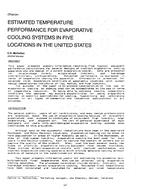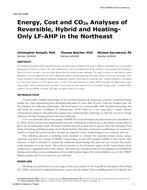Normal HVAC controls prevent use of the building mass as a thermal storage for night fan cooling or internal gain heating by keeping the masonry at a constant temperature. A diurnal room temperature swing of 7 F (4°C) has little effect on comfort, but allows large HVAC energy savings in concrete buildings. A low cost microcomputer predictive control that provides such temperature swings was developed and validated by use in a monitored test hut for 18 months. Good comfort was maintained, and the potential for large savings was demonstrated. On some nights, too much fan precooling could cause the purchase of heating the next day. This waste was usually prevented with a calculation using outdoor and indoor temperatures predicted 24 hours in advance. The control strategy was changed during the passage of weather fronts, which were recognized within four hours of their onset.
Units: Dual
Citation: Symposium, ASHRAE Transactions, 1988, vol. 94, pt. 1, Dallas, TX
Product Details
- Published:
- 1988
- Number of Pages:
- 20
- File Size:
- 1 file , 1.7 MB
- Product Code(s):
- D-DA-88-02-4


